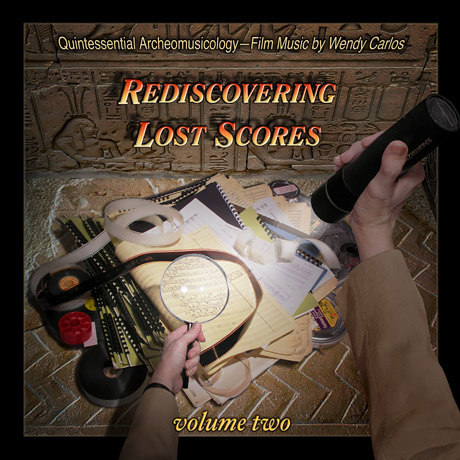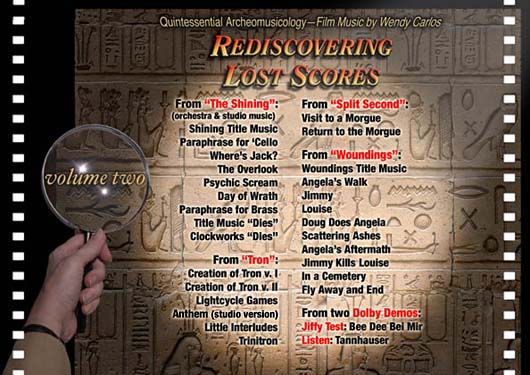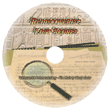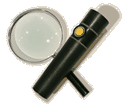 (Top
of the
Page)
(Top
of the
Page)


|
|
 About
Rediscovering Lost
Scores, volumes one and two-- About
Rediscovering Lost
Scores, volumes one and two--
With
the release of these disks we answer the requests of many of
you who have written over the years, and those who have sent
message to our website. Here are selected tracks from most
of my film score work, never available in any format until
these two volumes. It was, as the cover depicts, an exercise
in "Archeomusicology" to locate and check out stacks of
masters and pre-master tapes, listening to hours of music
which had been forgotten, and then carefully transfer many
tracks to high-res digital masters.
You will find a very eclectic mix of styles and musical
media represented herein. There are traditional orchestral
and chamber music ensembles, vocal solos and choruses, Moog
synthesizers, novel one-of-a-kind devices (like the Circon),
and on to recent digital tools. The majority of tracks are
hybrids -- blends of live with electro-acoustic media.
It's impossible for such a collection of music from over
three decades to emerge as a single project, aside from
their distinguishing characteristic, Lost Scores. Most of
the selections are composed pieces, while others ought be
categorized as "musical soundscapes", or "mood-setting
textures." But bear with us, we've tried to include
something for all of you, a broad range of musical
treatments.
Fortunately, nearly all of the master tapes remain
playable (a few required tape-baking). They all used Dolby-A
for low tape hiss, recorded on professional Ampex and 3-M
tape machines, never more than 2 tracks per quarter inch of
tape width. So dropout is low, and only a minimum of sound
cleaning and enhancement was necessary to render the
surprisingly high quality sound heard here, even when a few
generations of analog tape mixing were required for their
creation.
We were lucky to find several tracks that had escaped the
deadline searches during earlier remasterings of
Clockwork Orange and
Tron, and they're
included on this release. You'll see that we've ordered the
music mainly chronologically, with a split in volumes midway
through scoring The
Shining.
Nearly all of this music has never been available on
albums in any form, like most of our score to Kubrick's
The Shining, and my
entire score to the 1998 British SF antiwar movie,
Woundings. I worked on
three other films during the '80s and '90s. I'm still
searching for examples from two of those films, but was
fortunate to locate two tracks from a score I wrote for the
1991 British film, Split
Second. Political intrigue behind the scenes led
to canceling my score midway, a depressing experience film
composers are too familiar with.
Other music from that film found its way into the album,
Tales from Heaven and Hell, but two completed tracks were
orphaned. They're included on
Rediscovering Lost
Scores, with some other surprises. For those of
you who have been asking for CDs of my music to
The Shining (only two
excerpts were included on the original soundtrack LP), your
wish is finally met. It's a big relief to present this music
to you, pieces I began to fear would never see the light of
day.
--Wendy Carlos
|
 (Top
of the
Page)
(Top
of the
Page)
 Some
Liner Notes from Volume Two
Some
Liner Notes from Volume Two
|
 From
"The Shining"
(orchestral & studio music): From
"The Shining"
(orchestral & studio music):
1-Shining Title Music
We'll start off volume two with orchestral and studio
music composed for "The Shining." The brassy introductory
Fanfare is adapted from a Polymoog piece (on volume 1, #19),
here performed by large orchestra. It leads directly into
this more powerful arrangement of the title music heard in
the film: a blend of the Latin "Dies Irae" plainsong,
musical textures featuring Rachel's electrifying vocals, low
Moog drones, metal plectrum on autoharp, some delicate
high-pitched "Danny Bells", and an enveloping cross-delay
ambient wash. The "Dies" theme is not the original, but
comes from an adaptation Berlioz wrote for his "Symphonie
Fantastique."
2-Paraphrase for 'Cello
My vote for one of the best pieces here. You may not
recognize the "Dies Irae" theme that these romantic,
melancholy variations are based upon, although I followed
the chant closely. The ensemble consists of six 'celli and
two string basses. The musicians really "got into"
performing it, and their enthusiasm makes it remarkably
alive. I wish it appeared in the film, but Stanley explained
that all non-Berlioz variations "sounded wrong." It was my
fault in bringing up the Berlioz in the first place, when he
asked where he might hear the "Dies Irae" melody we were
planning to run with. He unwittingly became fixated on it,
which led to most of our music being rejected.
3-Where's Jack?
This orchestral selection is an impressionistic work
composed for the 8 AM morning scene, in which Wendy searches
for Jack only to discover his psychotic manuscript: "All
work and no play..." Unorthodox performance techniques on
traditional instruments create a near-electronic flavor,
although no synths were used. It was fun to compose directly
to full score pages (the more common "short-score" would
have been impractical here), and to end with those veiled
suggestions of what Stanley described as: "Jack becomes
Jaws", menacing and dangerous.
...
 From
"Tron": From
"Tron":
10-Creation of Tron version I
11-Creation of Tron version II
These two cues were created in a search for an
effective musical statement to begin Disney's pioneering
computer animation adventure. I'd forgotten about them until
stumbling upon an auxiliary master tape where they'd been
stored, unheard since 1982. Not as effective as the final
cue, they demonstrate a marriage of music and effects that
distinguish much of the score. Both were realized in the
studio, well before I began composing the final orchestral
cues..
12-Lightcycle Games
It's unfortunate that this stimulating music was
jettisoned late in production in favor of only sound effects
behind an important scene. While the effects are well done,
they lack the added dimension music provides. This was an
ideal place for the angular feel of quartal intervals and
harmonies (built on a musical fourth). Jorge Callandrelli
provided extensive help in assembling and "orchestrating"
most of the TRON music, following my detailed "short
scores." Contrast this excerpt with the reworked and
extended final shape the piece took on as Jupiter's moon,
"Io", in my Digital Moonscapes
suite.
...
|
 (Top
of the Page)
(Top
of the Page)
|
 From
"Split Second": From
"Split Second":
16-Visit to a Morgue
17-Return to the Morgue
In mid-1991 I was approached by two independent
filmmakers to score a British horror movie. The project
began well, and some memorable music resulted. Long story
short, someone else gained control of the film, and I was
dropped midstream. Infuriating. These two completed cues,
shelved until now, score very intense scenes, with
red-herring twists and scares. Note the elastic way the
music sneaks forward, hesitates, then picks up again, and in
#17 those two shattering fortissimos. It's written for
orchestra, realized with my LSI instrumental replicas. The
numerous "deliciously nasty" metallic effects are added via
HD audio.
...
 From:
"Woundings": From:
"Woundings":
18-Woundings Title Music
Six years later I was asked to score another British
movie. Roberta Hanley was the (American) director and also
wrote the screenplay. Based on a play by SF author Jeff
Noon, the film is classic antiwar, and probes the
bittersweet story of young British people caught up in an
unwinnable situation, their loves, and their losses.
(Note: this film has
recently become available on a new Sterling DVD, # 40730,
under the title: "Brand New
World.") The project went well, with a happy
ending, and some memorable music. The opening track,
featuring a gorgeous vocal by my old friend, Manya Zuba,
interweaves military with pastoral, accompanying a long
helicopter survey of a distant island, hauntingly bleak.
19-Angela's Walk
Even a tragic motion picture needs its lighter
moments. A young woman who is native to the island heads off
one early morning, and we follow, with a cheerful variation
of the main theme, here in a whistling performance by Manya,
accompanied by guitar, string, horn and harp. The
instrumental sounds (mostly assembled for my "Tales of
Heaven and Hell" album) reflect many months of building and
refining, and are highlighted througout the score.
...
 From
two Dolby Demos: From
two Dolby Demos:
28-Bee Dee Bei Mir
29-Listen: Tannhauser
Let's close with something completely different --
two tracks created for friends at Dolby Labs, especially VP
Ioan Allen. "The Jiffy Test Film" (1981) needed a musical
check that everything was well adjusted. Ioan asked if I
could come up with a minute or so of cheery synth music.
That evolved into this fully Bachian composition with its
preposterous two-note (D and B) theme, suggested by the
Dolby logo with its back to back "d" and "b" (or is it "b"
then "d"?). The title is a pun on Bach's "Bist Du Bei
Mir."
Completely different again is the longer realization
of the ending to Wagner's "Tannhauser" overture, for the
1982 Dolby demonstration film: Listen. Ioan wanted me to cap
it all off with a "grand switched-on treatment." Here's the
result, a complex multitrack synth performance, building to
an unabashed orchestral climax, as a horseback rider on
screen guides her steed up to a dramatic view in the Bay
Area, the camera pulls back and up, and the music soars in
dynamic surround sound.
...
(see complete track descriptions in
CD booklet)
|
 (Top
of the Page)
(Top
of the Page)
 Credits
and Special Thanks
Credits
and Special Thanks
|
Credits:
Remastered by Wendy Carlos with a special thanks to: Ioan
Allen and Dolby Labs, Clare Cooper, Manya Zuba, John Romkey,
and Mike Burg. All images created by Wendy Carlos. Layout by
Diane Waller.
Music tracks for "The Shining" produced
by Rachel Elkind-Tourre; all other tracks produced by Wendy
Carlos.
|
 (Top
of the
Page)
(Top
of the
Page)
 Back to the Discography Page
Back to the Discography Page
 Back to the wendycarlos.com Homepage
Back to the wendycarlos.com Homepage



